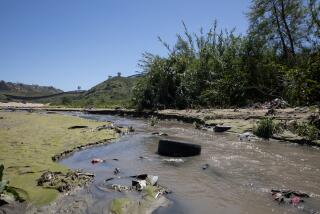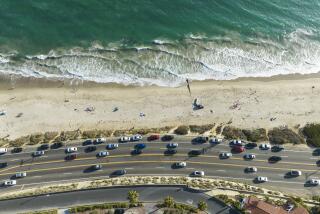Workers to Lift First Sections of Sewage Pipe : Spill: Calm waters will allow crews to bring pieces of damaged outfall pipe to the surface for inspection.
San Diego city officials said they expect work crews to lift up the first sections of damaged pipe from the ocean floor today as workers take advantage of a respite before the next storm to press on with repairs to the huge outfall pipe.
Alan Langworthy, water utilities department deputy director, said Monday that he was optimistic that engineers would get their first above-water look at the damaged pieces today. He added that city officials now expect to replace 22 sections of pipe, which is made from reinforced concrete.
Each section is 25-feet long and weighs about 30 tons. Repairs to the outfall pipe are estimated at $10 million.
“During the last two days (repair crews) have been able to get some work done. The weather has been clear and the ocean calm. . . . We think they can bring up some of the damaged pieces, because we’re going to have a representative from the manufacturer (that will make the new sections) and he has to confirm the (pipes’) measurements,” Langworthy said.
On Monday, repair crews dumped 2,000 tons of rock around the break in the pipe. Langworthy said said the rock was necessary to stabilize the pipe to prevent additional damage during future storms. Officials said wave action from last week’s powerful storms damaged some already weak sections of pipe further.
“Our concern was that the pipe would continue to fall apart in rough weather,” Langworthy said.
Normally, the outfall pipe discharges sewage--from which 75% to 80% of the solids have been removed--2.2 miles out to sea at a depth of 220 feet. However, because of the break in the pipe, 180 million gallons of sewage is being discharged daily about 3,150 feet offshore, and at a depth of 35 feet.
The resulting sewage plume, which is bubbling to the surface, has contaminated some city beaches, which have been closed to swimmers. The crisis was exacerbated during last week’s winter storms when the heavy rains caused millions of gallons of raw sewage from Tijuana to flow into the Tijuana River Valley and Pacific Ocean.
Water samples taken Sunday at Imperial Beach showed a fecal coliform count of 19,000 per 100 milliliters, Langworthy said. The accepted coliform count for safe bathing is 1,000, he said.
A sample taken at the Silver Strand also showed a coliform count 19 times over the acceptable limit, Langworthy said. He blamed the high counts in Imperial Beach and Coronado on the raw sewage spilling from Tijuana.
Samples taken Sunday at beaches near the city waste treatment plant at Point Loma also showed high coliform counts.
Langworthy said the count was 16,000 near the Point Loma Lighthouse, just south of the treatment plant. Samples taken near the plant showed a coliform count of 20,000, while samples taken by the Ocean Beach pier showed a count of 2,000, he said.
However, the bacterial readings at San Diego beaches are greatly influenced by tides, currents, wind and weather.
For example, samples taken Saturday at Point Loma showed a coliform count of 76, Langworthy said, almost 16,000 times lower than Sunday’s reading.
“It all depends on how the tides and currents are pushing the (sewage) plume. . . . The currents have been Ping-Ponging the plume back and forth. If the weather ever settles down we will see the plume move in just one direction,” Langworthy said.
More to Read
Sign up for Essential California
The most important California stories and recommendations in your inbox every morning.
You may occasionally receive promotional content from the Los Angeles Times.










